Traditional Turkish Coffee
What visit to Turkey would be complete without trying Turkish Coffee? After 500 years of coffee history, the traditional Turkish coffee is still plentiful throughout Turkey and makes a perfect break in any long day of sightseeing. Many Turks consider coffee to be Turkey’s gift to the world.
We were fortunate, on our visit to Topkapi Palace there was an exhibit “A Drop of Pleasure: 500 Years of Turkish Coffee”, which was sponsored by UNESCO. Some interesting facts: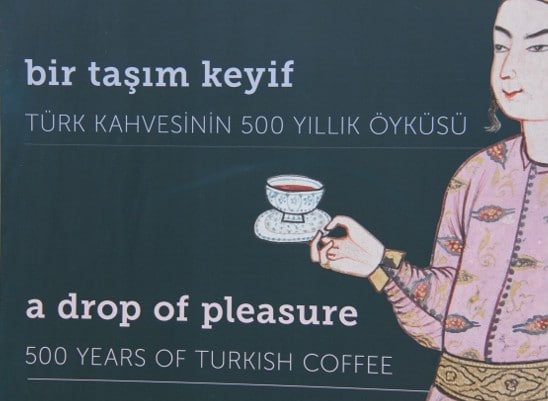
- In 1554 during the reign of Sultan Suleiman the Magnificent, coffee was first introduced to the Sultan from the Ottoman Territory of Yemen.
- The Sultan had a position in his imperial kitchen, the kahvecibaşı, responsible for preparing his coffee. (Coffee is kahve in Turkish).
- Shortly thereafter public coffee houses opened where men gathered for social purposes to enjoy a coffee and a smoke of the water pipe (nargile).
- Women had social gatherings over coffee within the home.
- Excavations near Izmir revealed a coffee cup, which resembles today’s espresso cup, dated 2 B.C.
- Coffee was traditionally ground into a “powder” then roasted and brewed over open coals. Methods which still survive today. (See Kadikoy and traditional Turkish coffee in this post for more information).
- From Turkey, which at the time was the center of many trade routes, coffee spread from Africa into Europe.
Armed with this information we set out to find some Turkish coffee fit for a Sultan.
The Ritual of Turkish Coffee
(or just coffee when you are in Turkey)
The whole process can be summarized into four steps:
- Roasting:the beans are traditionally roasted over charcoal coals. Tahmis is Turkish for roasting and Tahmis Street can be found in Istanbul in Eminonu near the Egyptian Spice Bazaar. This is the birthp
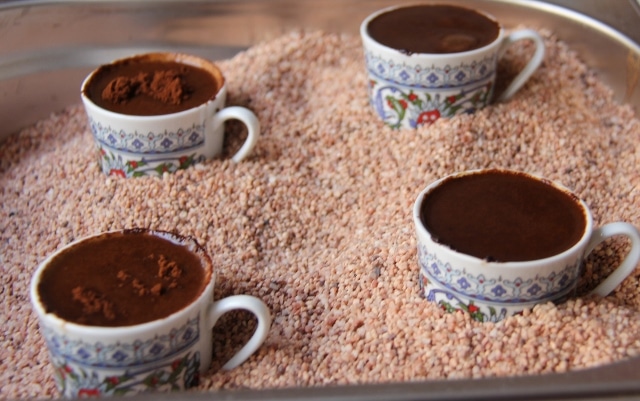 lace of coffee roasting and many shops still exist here.
lace of coffee roasting and many shops still exist here.
- Grinding: Traditionally at home in a wooden or metal coffee grinder for commercial production stone grinding was the norm (Today this is done by machines.) Turkish coffee is a very find grind, almost a powder, the most popular brand of coffee in Turkey is Kurukahveci Mehmet Efendi.. When drinking Turkish coffee the coffee settles to the bottom of the cup, leaving a coating. These are left in the cup and Turks have a tradition of “reading” the remains in your cup to tell your fortune. You can still find places doing this today.
- Making: In Kadikoy, there were many Turkish coffee houses and you could see it being made in the traditional copper pot , or cezve,over hot coals. This method traditionally takes 15-20 minutes. The coffee is often removed several times during the process to prevent overheating and scorching the coffee.
In Fethiye, we came across Dibak Kahve, or mortar coffee. This is stone ground Turkish coffee “cooked” in your cup. It is made in the cup in what looks like hot sand, but is actually fine hot c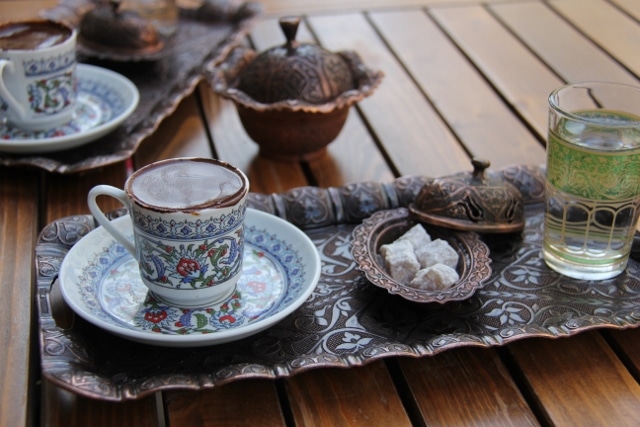 oals.
oals.
- Serving: The service is definitely picture worthy, arriving on the traditional tray and accompanied by a fine example of nutty lokum (Turkish Delight). This is the traditional serving of Turkish coffee and serves to remind us that coffee was a special social ritual. The cups, fincan, are about the size of espresso cups.
The 500 year old coffee traditions live on in modern Turkey.
Modern Coffee Influences
If Turkish coffee is not to your liking more modern forms of coffee are also available. Many of the large Italian roasts are found in coffee shops; Illy and Lavazza are the most common. Single Roasts and small coffee shops are also popping up.
Istanbul is the easiest place to find good coffee of the non-Turkish variety. In Cihangir, where we stayed, these small coffee shops were plentiful. As we are coffee snobs, we were delighted to find there were enough options we could try a different one every day. It is probably the best selection of coffee we have found in our travels outside of Melbourne, Australia (which for us is the undisputed coffee capital of the world.)
You can have your coffee served in the manner of your choice (Aeropress, syphon, pour over, french press, latte, cappuccino, machiatto, espresso or just filter coffee) and at some places pick the origin of your beans. All of this of course comes at a price and we were a bit amazed a good cup of coffee here cost about the same as Melbourne ($3 USD). Wages here would not be as high as Melbourne so more modern coffee would be a treat.
Some recommendations in Cihangir: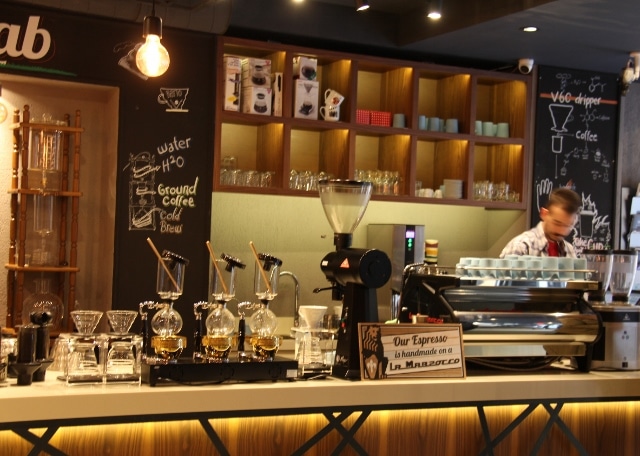
- Brew Lab (pictured at left)- the sign outside “2015 Turkish Barista Champion” caught our eye, and the coffee did not disappoint. Unfortunately, it does not open until 10am.
- Geyik a funky little cafe by day and a groovy cocktail bar by night. (Coffee until 12 pm, cocktails start at 5 pm.)
- Kronotrop a small roaster and coffee house. Wide selection of single roasts for purchase. In true coffee aficionado form, only one size of coffee is served.
- Journey our favorite, and they also serve a fantastic breakfast which is highly recommended! (It might be the best breakfast outside of Melbourne)!
Our only complaint, we didn’t have enough time to try all the options in the area!
Turkish Tea
Not into Turkish coffee, no fear, tea is everywhere! Much more common than coffee and cheaper! Cay is offered at every social interaction, even shop keepers will often offer you a cup of tea while you browse their shop. It seems to appear from nowhere. At the market, in the Grand Bazaar, everywhere really, you see someone appear with a tea caddy and everyone grabs a fresh cup of tea.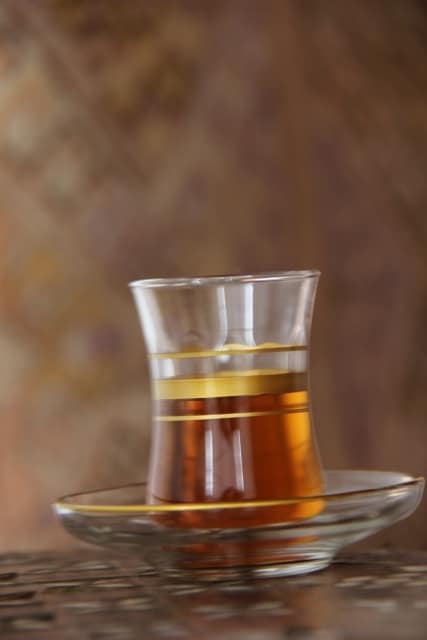
The most common tea is traditional black tea, or orange pekoe. Apple, pomegranate, mint, and lemon and/or ginger are also easy to find, Be aware though that in some places, these types of teas are not “herbal” teas but instead are made from tea “pellets” and I am sure they contain preservatives and sugar. You can see both types of teas at any market or the Egyptian Spice Bazaar in Istanbul. Nicer cafes serve herbal teas and you can usually tell by the price. More expensive tea is real tea. The cheaper herbal teas (2 TL or so) are not usually real herbs, but the pellets. If in doubt you can tell when you taste it.
The serving cups and teaspoons used for tea are elegant. Pasabahce a large Turkish glass maker has some fine examples of Turkish tea glasses. On Istikial Caddesi (Street) there is a large Pasabahce store (No. 314) which features many of their handmade items.
And in a nod to Turkish ingenuity, we found the Turkish teapot to be one of the cleverest items we have encountered for a while. We will definitely be adding this to our kitchen. If you like tea it is a must have item. You place the tea in the top pot with water and just water in the lower chamber. Place it on the stovetop, or wood fired oven if you use one to heat your home, and as you need a cup of tea you can adjust to the correct strength with a steady supply of tea and hot water. (An electric version is also available.)
It is traditional to serve Turkish coffee with a glass of water and some lokum (Turkish Delight)
| Servings | Prep Time |
| 2cups | 5minutes |
| Servings | Prep Time |
| 2cups | 5minutes |
- Add the water and the sugar into a cevze. Bring the water/sugar mixture to a boil and remove the cevze from the heat immediately upon boiling.
- Add the Turkish coffee. Return the cevze to the stove, this time at low heat. Upon boiling, immediately remove the cevze from the heat. Discard any accumulated foam and mix well.
- Return the cevze to the stove, this time at low heat. Upon boiling, immediately remove the cevze from the heat. Allow coffee powder to settle. You can add a tablespoon of cold water to the cevze to promote settling.
- Pour into cups (fincams) and serve. It is helpful to let it settle a bit after pouring into the cup as there will still be coffee (powder) in the water. It will also be very hot so be careful.
- It is traditional to serve Turkish coffee with a glass of water and some lokum (Turkish Delight).
- Do not drink all the way to the bottom of the cup, as there will be powder where it has settled in the cup.

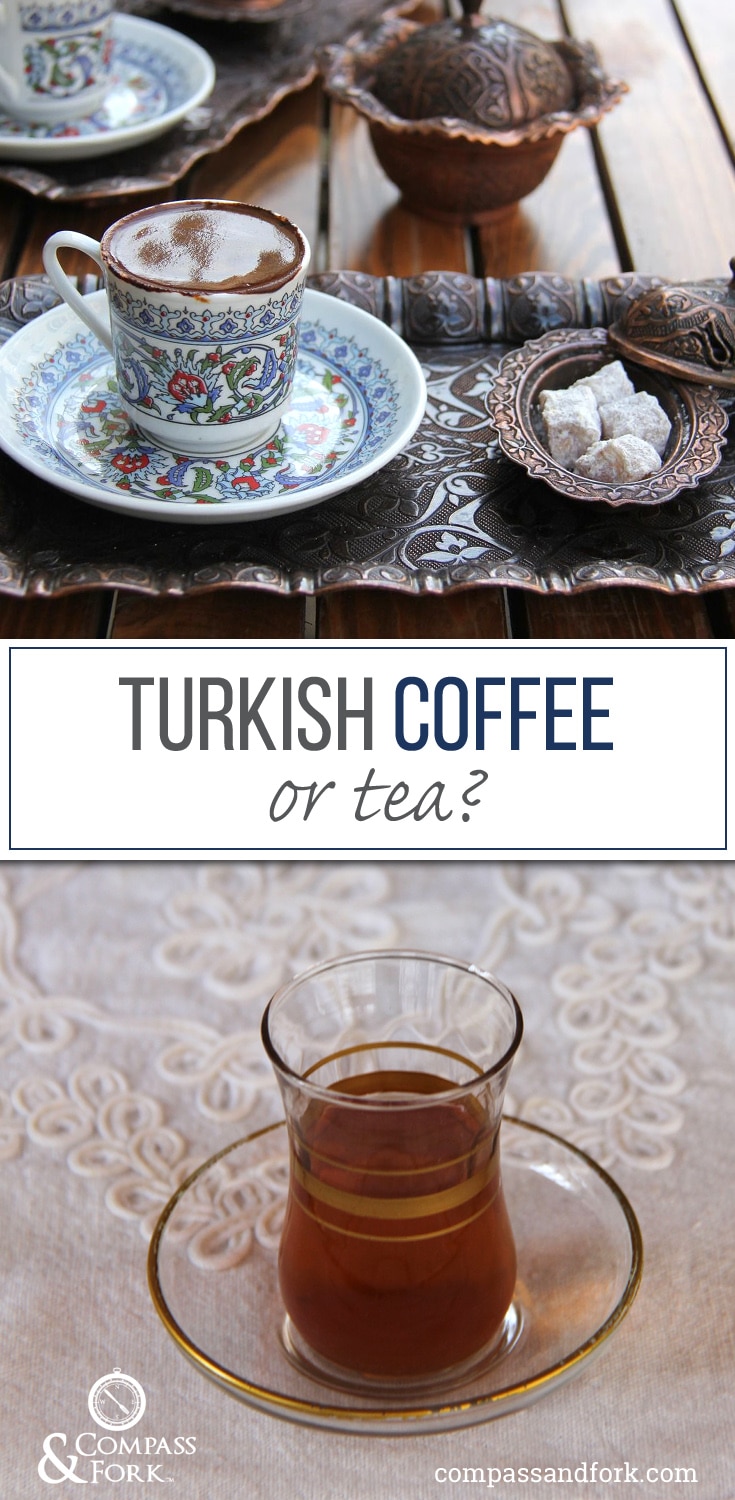

Nancie Lee
I’m not a hot coffee drinker, but I definitely want to try this one day. I love cultural experiences and this looks like one you must sit and enjoy. The mortar coffee is very interesting. No mention of sugar or cream in the process. Do they strictly drink it black? Thanks for sharing!
Editor
Thanks for your comment. I don’t recall anyone using milk, all served black. The coffee was always full to the brim. You could get it sweeter if you wanted.
Anda
I used to drink Turkish coffee till I moved to the USA. It was very, very strong.
Editor
Thanks for your comment Anda. Turkish coffee is strong and thick isn’t it? I quite enjoyed it I must admit.